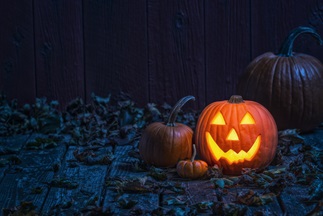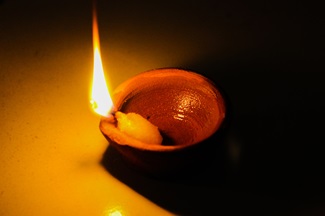Apr 14, 2025
Apr 14, 2025
by Sujata C
From Yamadeepam to Jack-o’-Lanterns
It’s the season of lamps and lights across the world. Last month we had Deepavali, the five-day Indian festival that celebrates the return of Lord Rama to Ayodhya after killing the demon, Ravana. Sometime later in the West carved pumpkins came out with lamps inside them to celebrate Halloween.
Both these festivals come around in the same week.
 Halloween, celebrated globally as a festival of spooks and spirits, has roots intertwined with ancient traditions. Halloween is predominantly associated with Celtic practices, but parallels can be drawn between Halloween and Hindu rituals, particularly Yamadeepam, a practice observed during Deepavali (Diwali) in the month of Aswin or Asweeja in India, more specifically on Dhanteras.
Halloween, celebrated globally as a festival of spooks and spirits, has roots intertwined with ancient traditions. Halloween is predominantly associated with Celtic practices, but parallels can be drawn between Halloween and Hindu rituals, particularly Yamadeepam, a practice observed during Deepavali (Diwali) in the month of Aswin or Asweeja in India, more specifically on Dhanteras.
Both traditions honor souls and spirits and symbolize the light overcoming darkness, bridging the mortal and spiritual realms. A month prior to this in the Hindu month of Bhadrapada comes the Mahalaya paksha when the souls of the ancestors descend to the Earth and spend a fortnight here. Food is offered to Brahmins to appease the ancestors.
 In the Hindu culture, Yamadeepam is dedicated to Yama, the God of Death. Families light oil lamps outside their homes for Lord Yama to ensure protection from untimely death. This practice emphasizes gratitude to ancestors and maintaining a connection with those who have passed on. The lamps symbolize hope, continuity and the transcendence of fear over death—a theme that echoes with Halloween’s core essence.
In the Hindu culture, Yamadeepam is dedicated to Yama, the God of Death. Families light oil lamps outside their homes for Lord Yama to ensure protection from untimely death. This practice emphasizes gratitude to ancestors and maintaining a connection with those who have passed on. The lamps symbolize hope, continuity and the transcendence of fear over death—a theme that echoes with Halloween’s core essence.
The Akasha Deepam lit in the month of Karthik that follows the month of Aswin is again a month-long festival where lamp lighting is a daily ceremony. This divine lamp provides the light of protection and also lights up the path of the ancestors who are returning to the Pitru Loka.
Koti Deepotsavam is the new age trend of this festive month wherein lamps of devotion are lit on ghats of rivers and open grounds, a spectacular and a divine treat for the eyes. On the auspicious day of Karthik Poornima or Dev Deepavali devotees’ light ghee lamps made of 365 wicks to represent light for each day of the year and also to invoke blessings, prosperity and protection. Lamps are also lit on the Indian gooseberry and offered to the full moon. The Full Moon is the bestower of good health as is the amla.
A point worth noting in these festivals of lights is the common thread that runs across cultures. Jack-o’-lanterns, a central feature of Halloween, shares a striking resemblance to Yamadeepam. According to Celtic lore, carved pumpkins are lit from within to protect against wandering malevolent spirits. The Gauls would carve turnips in a similar fashion to dispel negative energies. Likewise, the lamps of Yamadeepam are placed to guard against negative energies, acting as a protective light for the living and the deceased alike.
Another connection lies in the timing of the festivals. Halloween coincides with Samhain, a festival of ancient Celts, marking the end of the harvest and the onset of winter, a threshold period believed to blur the boundaries between the living and the dead. Diwali, too, marks a transition—heralding the New Year in certain Indian calendars. The Marwari New Year is celebrated during the day after Diwali on Balipratipada. This period of transition symbolizes renewal and cleansing, both spiritual and material. In the West the celebration that begins with Halloween ends with All Souls Day. Trick-or-treating custom is part of this celebration and fosters community engagement. The sharing of sweets during Diwali similarly builds communal bonds.
These cultural parallels show how humanity, across geographies, has long grappled with the mysteries of life, death and the afterlife. Whether through Jack-o’-lanterns or Yamadeepam, the universal desire to honor the dead and seek protection remains a timeless and shared tradition. These activities also promote a sense of community and collective spirituality.
Images (c) istock.com
16-Nov-2024
More by : Sujata C